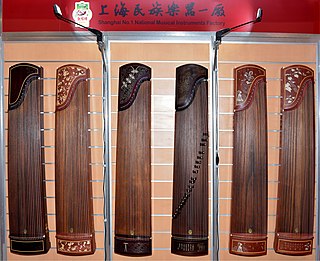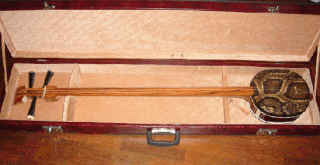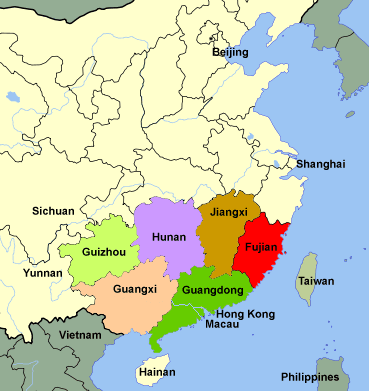
Chaozhou, alternatively Chiuchow, Chaochow or Teochew, is a city in the eastern Guangdong province of China. It borders Shantou to the south, Jieyang to the southwest, Meizhou to the northwest, the province of Fujian to the east, and the South China Sea to the southeast. It is administered as a prefecture-level city with a jurisdiction area of 3,110 km2 (1,200 sq mi) and a total population of 2,568,387. Its built-up area encompassing most of Shantou and Jieyang cities was home to 12,543,024 inhabitants on 13 local administrative areas. Along with Shantou and Jieyang, Chaozhou is a cultural center of the Chaoshan region.

The music of China consists of many distinct traditions, often specifically originating with one of the country's various ethnic groups. It is produced within and without the country, involving either people of Chinese origin, the use of traditional Chinese instruments, Chinese music theory, or the languages of China. It includes traditional classical forms and indigenous folk music, as well as recorded popular music and forms inspired by Western culture.

The zheng or guzheng, is a Chinese plucked zither. The modern guzheng commonly has 21, 25, or 26 strings, is 64 inches long, and is tuned in a major pentatonic scale. It has a large, resonant soundboard made from Paulownia wood. Other components are often made from other woods for structural or decorative reasons. Guzheng players often wear a fingerpick made from materials such as plastic, resin, tortoiseshell, or ivory on one or both hands.

The term Chinese orchestra is most commonly used to refer to the modern Chinese orchestra that is found in China and various overseas Chinese communities. This modern Chinese orchestra first developed out of Jiangnan sizhu ensemble in the 1920s into a form that is based on the structure and principles of a Western symphony orchestra but using Chinese instruments. The orchestra is divided into four sections – wind, plucked strings, bowed strings, and percussion, and usually performs modernized traditional music called guoyue. The orchestra may be referred to as Minzu Yuetuan or Minyuetuan in mainland China, Chung Ngok Tuen in Hong Kong, Huayuetuan in Southeast Asia, or Guoyuetuan in Taiwan.

Chaoshan or Teoswa is a cultural-linguistic region in the east of Guangdong, China. It is the origin of the Min Nan Chaoshan dialect (潮汕话). The region, also known as Chiushan in Cantonese, consists of the cities Chaozhou, Jieyang and Shantou. It differs linguistically from the rest of Guangdong province, which was historically dominated by Yue speakers, Hakka, and Leizhou Min speakers. However, Mandarin has recently become the dominant language in the region. It is historically important as the ancestral homeland of many citizens of other countries of Chinese descent, including Viets, Thais, Cambodians, Singaporeans, Malaysians, and Indonesians.

Music of Guangdong is a synthesis of a number of local Guangdong folk music styles.

The gaohu is a Chinese bowed string instrument developed from the erhu in the 1920s by the musician and composer Lü Wencheng (1898–1981) and used in Cantonese music and Cantonese opera. It belongs to the huqin family of instruments, together with the zhonghu, erhu, banhu, jinghu, and sihu; its name means "high-pitched huqin". It is the leading instrument of Cantonese music and opera ensembles. Well known pieces for the gaohu include Bu Bu Gao and Ping Hu Qiu Yue.

The sanxian is a three-stringed traditional Chinese lute. It has a long fretless fingerboard, and the body is traditionally made from snake skin stretched over a rounded rectangular resonator. It is made in several sizes for different purposes and in the early 20th century a four-stringed version, the jiaxian sanxian (加弦三弦), was developed. The northern sanxian is generally larger, at about 122 cm (48 in) in length, while southern versions of the instrument are usually about 95 cm (37 in) in length.
Guangdong music, also known as Cantonese music is a style of traditional Chinese instrumental music from Guangzhou and surrounding areas in Pearl River Delta of Guangdong Province on the southern coast of China. The name of the music is not an accurate description because Guangdong music is not the only music of the whole Guangdong area. Cantonese classical music especially were usually much livelier in pace and happier than those of other China provinces which is typical and the very essence of the Cantonese's character. In Guangdong, there are numerous traditional genres of music such as Teochew music and Hakka music. The name of the music originated in the 1920 and 1930s when the music was popular in Shanghai ballrooms in the form of "Spiritual Music". As the performers were almost entirely from Guangdong, Shanghai people generalized the form of music as Guangdong music. Musically, compositions are based on tunes derived from Cantonese opera, together with new compositions from the 1920s onwards. Some pieces have influences from jazz and Western music, using syncopation and triple time, and incorporating instruments such as the saxophone, violin, guitar, piano, drum set, or xylophone.

The erxian is a Chinese bowed string instrument in the huqin family of instruments. It has two strings and is used primarily in Cantonese music, most often in "hard string" chamber ensembles. In the 1920s, following the development of the gaohu, the erxian experienced a decline and since the late 20th century has been little used outside the tradition of Cantonese opera.

Nanguan is a style of Chinese classical music from the southern Chinese province of Fujian. It is also popular in Taiwan, particularly Lukang on west coast, as well as among Overseas Chinese in Southeast Asia.
The Teochew people or Chaoshanese, Teo-Swa people or Chaoshan people is an ethnic group native to the historical Chaoshan region in south China who speak the Teochew language. Today, most ethnic Teochew people live throughout Chaoshan and Hong Kong, and also outside China in Southeast Asia, including in Singapore, Malaysia, Thailand, Cambodia, Vietnam, and the Philippines. The community can also be found in diasporas around the world, including the United States, Canada, Australia, New Zealand, and France.
The term guban refers collectively to a small drum and paiban (clapper), which are played simultaneously, by a single player, in traditional Chinese music.
Jiangnan sizhu is a style of traditional Chinese instrumental music from the Jiangnan region of China.
The yehu is a bowed string instrument in the huqin family of Chinese musical instruments. Ye means coconut and hu is short for huqin. It is used particularly in the southern coastal provinces of China and in Taiwan. The instrument's soundbox is made from a coconut shell, which is cut on the playing end and covered with a piece of coconut wood instead of the snakeskin commonly used on other huqin instruments such as the erhu or gaohu. As with most huqin the bow hair passes in between the two strings. Many players prefer to use silk strings rather than the more modern steel strings generally used for the erhu, giving the instrument a distinctly hollow, throaty timbre. The instrument comes in various sizes. In Chaozhou music it is a leading instrument, and is tuned quite high. In Cantonese music it can be quite large and is often tuned to a relatively low pitch, lower than the erhu. It is used as an accompaniment instrument in the local musics and operas of various areas, including Guangdong, Fujian, and Taiwan. It is an important instrument in the music of the Chaozhou and Hakka peoples. In Taiwan, a variety of yehu used in Taiwan opera is called kezaixian.

Teochew string music or Chaozhou xianshi is classed as a type of sizhu music although it typically uses stringed instruments only. It is found in northeastern Guangdong and parts of Fujian and also in regions with overseas Teochew populations, such as Malaysia, Singapore, Thailand, and the United States. The Chaoshan region of Guangdong, bordering on Fujian and comprising the cities of Chaozhou, Shantou and Jieyang, forms its own cultural sphere. Teahouses often accompany with Chaozhou music.

The paiban is a clapper made from several flat pieces of hardwood or bamboo, which is used in many different forms of Chinese music. There are many different types of paiban, and the instrument is also referred to as bǎn (板), tánbǎn, mùbǎn, or shūbǎn (书板). Typical materials used for the paiban include zitan, hongmu, or hualimu, or bamboo, with the slats tied together loosely on one end with cord. It is held vertically by one hand and clapped together, producing a sharp clacking sound.
A qupai is the generic term for a fixed melody used in traditional Chinese music. The literal meaning is "named tune," "labeled melody," "titled tune," or "titled song". Qupai are relatively brief, most comprising between 20 and 70 measures in 2/4 meter. Many qupai are centuries old, but only a few of these have been handed down to the present.

The Chinese province of Fujianhas musical traditions that can be traced back to at least the Tang dynasty. Today the music of Fujian can be heard not only in the province itself, but also in overseas communities, particularly Taiwan.













